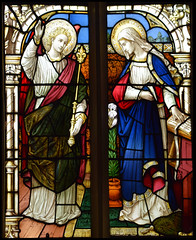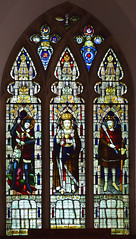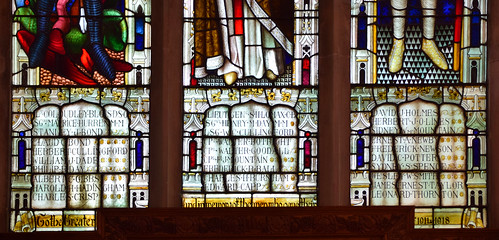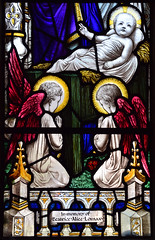| |
|
 |
|
I hadn't been back to
Yoxford for years. If you are a cyclist, it isn't
the easiest place to get to. There are few
Suffolk villages which are only approached by
main roads, but Yoxford is one of them, and it
wasn't until August 2017, more than fifteen years
after my previous visit, that I took my life in
my hands and cycled down the A12 from Darsham.
And yet, I'd always liked Yoxford. I remembered
writing on the occasion of my previous visit that
if, against all my better judgements, a day came
when I tired of my shameless hedonistic urban
lifestyle and decided to retire to the country,
and money were no object, then Yoxford would be
pretty near the top of my list. It was big enough
to have three decent pubs, a few good shops, one
of which was one of Suffolk's best second-hand
book shops, and even had a railway station half a
mile to the north. And after all, the A12 didn't
actually run up the high street. There were some
pretty houses and even a park. And it was still a
village. What more could I want?
The name of the village means a ford where oxen
can pass (as, of course, does the name of the
city without the Y in front). The little stream
that comes down from the industrial village of
Peasenhall a couple of miles off is referred to
locally as the River Yox, but this is a
backnaming, the stream named after the village
rather than the other way around. Yoxford
proclaims itself 'the garden of Suffolk' as a
result of the intensive fruit farming that began
here a couple of centuries ago. And it will come
as no surprise to learn that Yoxford is
alphabetically last of Suffolk's 500-odd
parishes.
|
Well, the second-hand bookshop has
long gone, and so has one of the pubs. I couldn't tell
you if either of the others are still decent, as I didn't
call at them. But St Peter is still a fine sight with its
grand spire, so unusual in Suffolk. Obviously, given the
dedication, there is a cock on top of it. This church is
one of the last of what I think of as the large southern
Suffolk churches you meet heading north, before hitting
the Blythburgh/Southwold/Covehithe group which give a new
meaning to grandeur. And yet, stepping inside, it is hard
to shake off the impression that this is a town church,
for it has an urban quality to it. Partly, this is
because of the 19th Century restoration at the hands of
Richard Phipson, but it is also because of the monuments
and brasses that line the walls. Significant names from
Suffolk history can be found on them, for important
people seem often to have lived around here.
One of them not buried here was Charles Brandon, Duke of
Suffolk, who was the second husband of Henry VIII's
little sister Mary, who had previously been married to
the King of France. Their grand-daughter was Lady Jane
Grey, who for a brief, teenage week in 1553 was
proclaimed Queen of England by the desperate protestant
advisers to Edward VI, aghast at having a dead young king
on their hands. Their cunning plot to impose extreme
protestantism on England was foiled by the popular
acclamation of the accession of Mary I, who was staying a
few short miles away from here at Framlingham. Mary's
reign would prove to be short and unhappy, and young Jane
paid with her life for the treasonable actions of those
scheming old men. But if the protestants had succeeded in
their plan, England would have been quite different
today. There certainly would not have been a Church of
England, for instance.
The view to the east is of wide
open spaces, with aisles running down to meet the
chancel. The focus is the War memorial east window of
1920 by Lavers & Westlake, depicting Christ in
Majesty flanked by St George of England and St Edmund of
East Anglia. What makes it so interesting is that the
names of the Parish dead are also in glass in the lower
part of the window.
   
It was almost half a millennium
before, at the end of another great war, that Thomasina
Tendrynge died in 1485, the year of the Battle of
Bosworth Field and in which the accession of Henry Tudor
would kickstart the dramatic events of the next two
centuries for the English people. Thomasina was the
daughter of William Sydney, himself an ancestor of the
family who would find favour with Henry's grand-daughter
Elizabeth a century later, being given Penshurst castle
in Kent.
Her brass, and those of her seven children, are set on
the south side of the sanctuary. Thomasina is wrapped in
a shroud, a striking if not unusual style for brasses at
the time. Two things make this one rather uncommon,
however. Firstly, she is stunningly beautiful, and she
gazes out at us with wide eyes from the elegant curve of
her winding. When he first saw her, my young son said
that she looked like a mermaid, and so she does.
Secondly, although two of her daughters stand beside her
in Tudor robes, her five other children are also in
shrouds, indicating that they died before she did.
A fine pair of earlier brasses nearby are to John and
Matilda Norwiche. We know very little about them, except
that they are responsible for St Peter's being here. John
was probably a member of the Norwiche family of
Mettingham castle. Matilda died childless in 1417. John
succeeded to the Lordship of Cockfield Manor in Yoxford
in 1422. He never took up the reins however, preferring
to remain elsewhere, possibly Mettingham. The Manor was
sold, and the proceeds were used to completely rebuild
this church in the prevailing Perpendicular style. John
himself died in 1428, and these brasses remain as a sign
on their patronage.
Two hundred years later, the Manor was in the hands of
the Brooke family, and Joan Brooke survives in the form
of a characterful brass in the south aisle. There are
several others, all worth a look. But these brasses
really should not be mounted on the walls. I realise that
this is done with the best of intentions, to allow them
to be displayed, and to protect them from being walked
on. The trouble is, if there was a fire, and these do
happen in churches from time to time, the brasses would
melt, and run down the walls. Floor-mounted brasses set
in stone do not melt, because the heat rises away from
them.
Later, the Manor would come to the Blois family, who were
remembered in the name of the pub that closed. St Peter
still remembers them, with a splendid array of ten
hatchments, mostly beneath the tower. There are also a
couple of fine wall monuments to the family, one of them
to the long-lived Sir Charles Blois, which has been very
clumsily relettered at some point. Mortlock tells us that
the sculptor was Thomas Thurlow, whose work can be found
widely in this part of Suffolk. Sir Charles was ever
feelingly alive to the duties of his station,
apparently, as well as being faithful and earnest in
the discharge of them.
My favourite memorial is a very simple one, but it
remembers one of the great and often unsung heroes of
church explorers. This is David Elisha Davy. The
agricultural depression of the 1820s pushed him into an
early retirement, which he spent travelling around
Suffolk, sketching and taking an inventory of the
exterior and contents of medieval churches.
It is no exaggeration to
say that he rediscovered Suffolk's churches,
which had mostly been in a state of neglect since
the early 17th century. His vast body of research
is still largely unpublished, although it is
possible to view it in the British Library, and
his lively account of his journey is available in
a Suffolk Records Society publication. This is an
absolute must-read for anyone interested in
Suffolk's churches - Suffolk Library Service has
loads of copies. Davy created a priceless record
of the county's churches on the eve of their
Victorian restoration. In many cases, his record
is the only one we have of the churches between
the Reformation and the modern age.
White's Directory of Suffolk tells us that, by
1844, Davy had already headed off to his other
house in Ufford. But Yoxford could still boast no
less than five tailors, four milliners, and even
a staymaker. The Directory also reveals that this
large village (1500 people even then) could
sustain a lifestyle considered so harmonious that
Anglican ministers of surrounding villages
thought it worthwhile abandoning their parishes
and living here instead. The Vicar of Ubbeston
for example (although that church is now a
private house), but also the Rector of Middleton,
Fordley, Westleton and Peasenhall, the splendidly
named Reverend Harrison Packard. Today, all these
villages come within the benefice of Yoxford.
Ironically, of course, those 19th Century
clergymen moved to Yoxford because of the
trappings of an urban lifestyle it could provide. |
|
 |
|
|
|